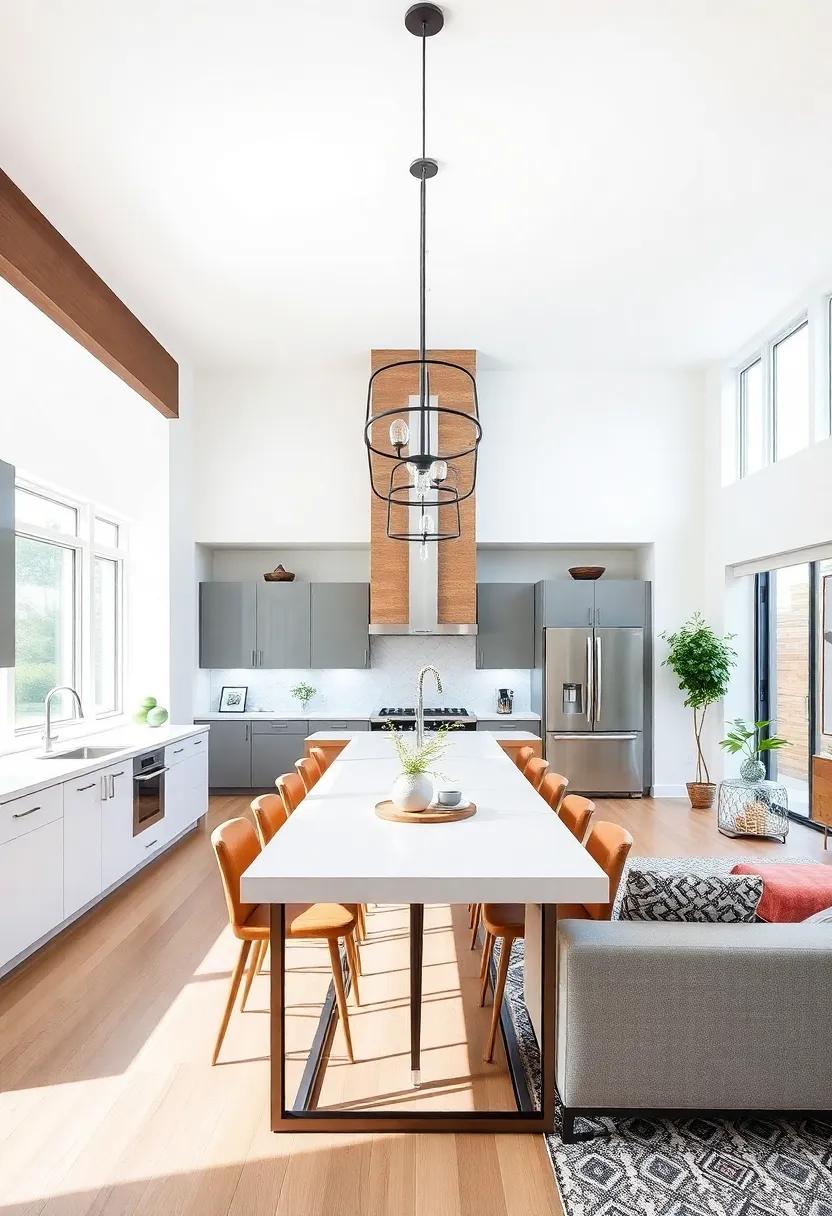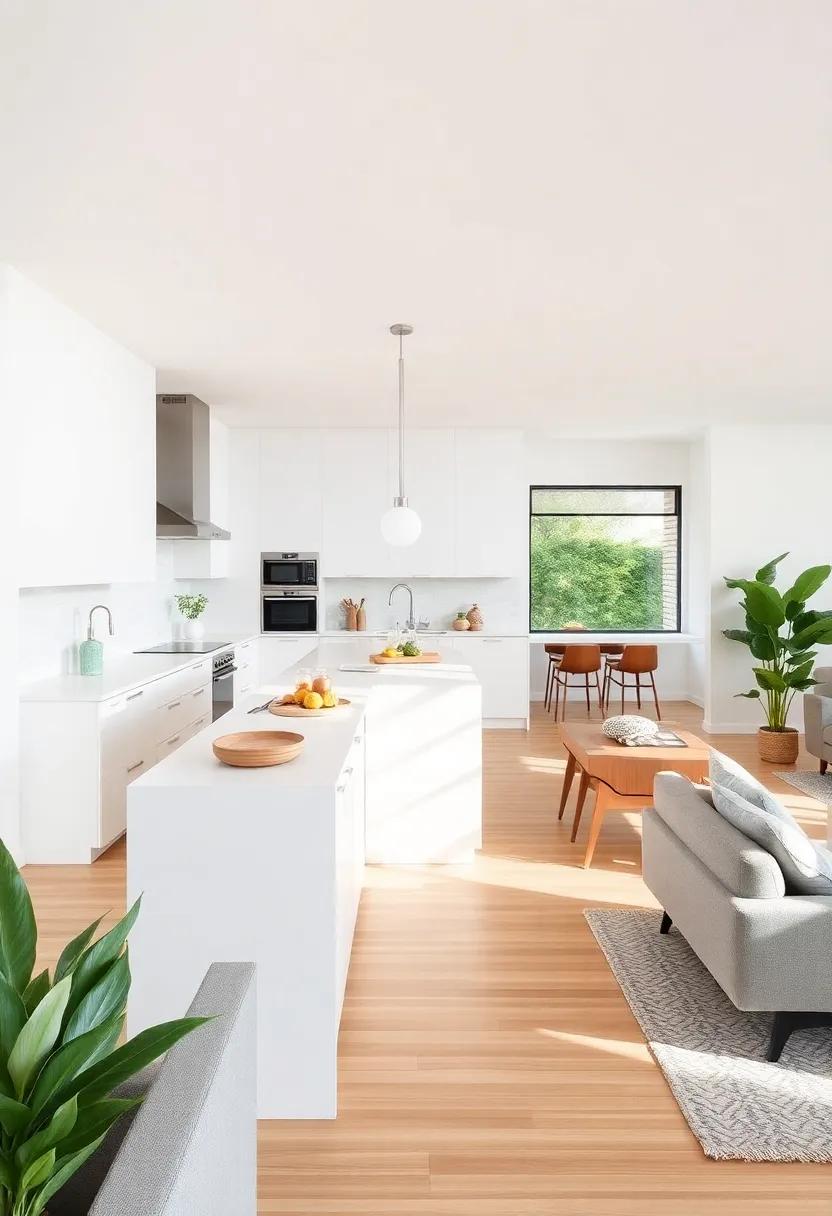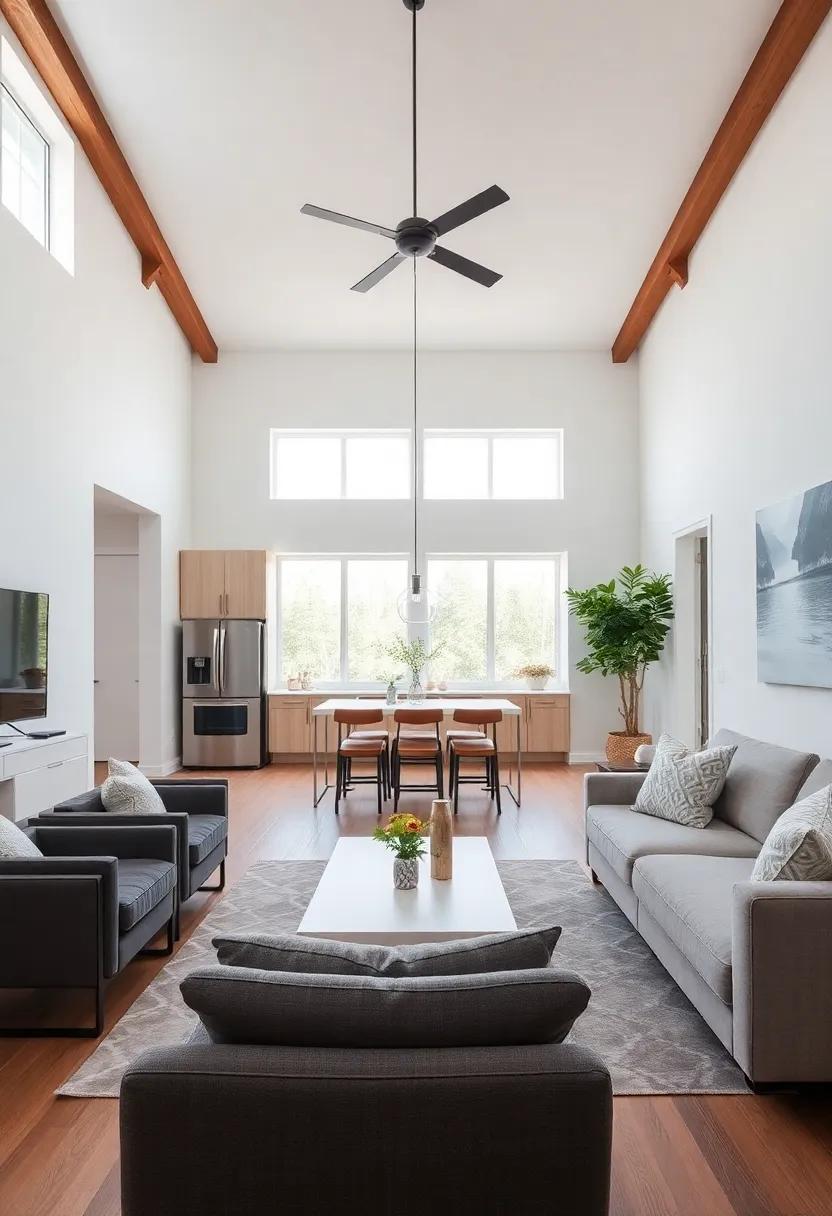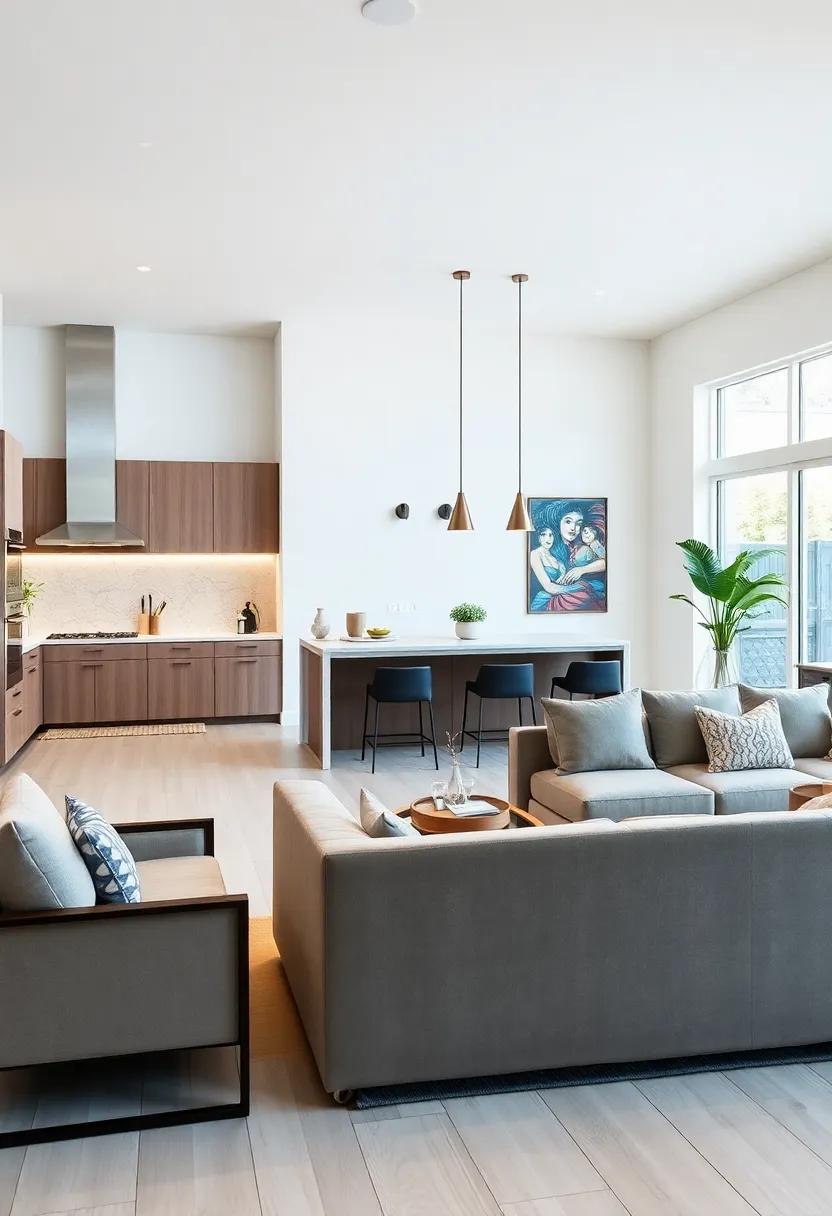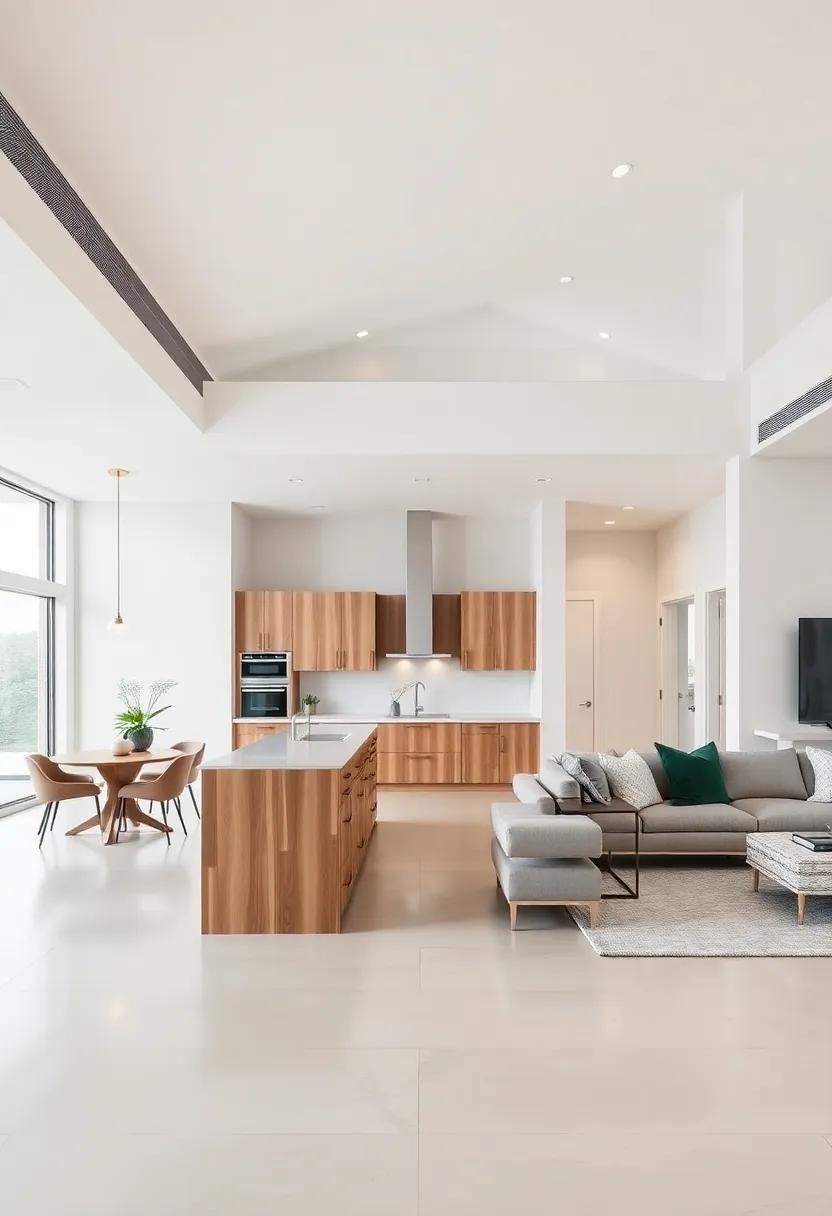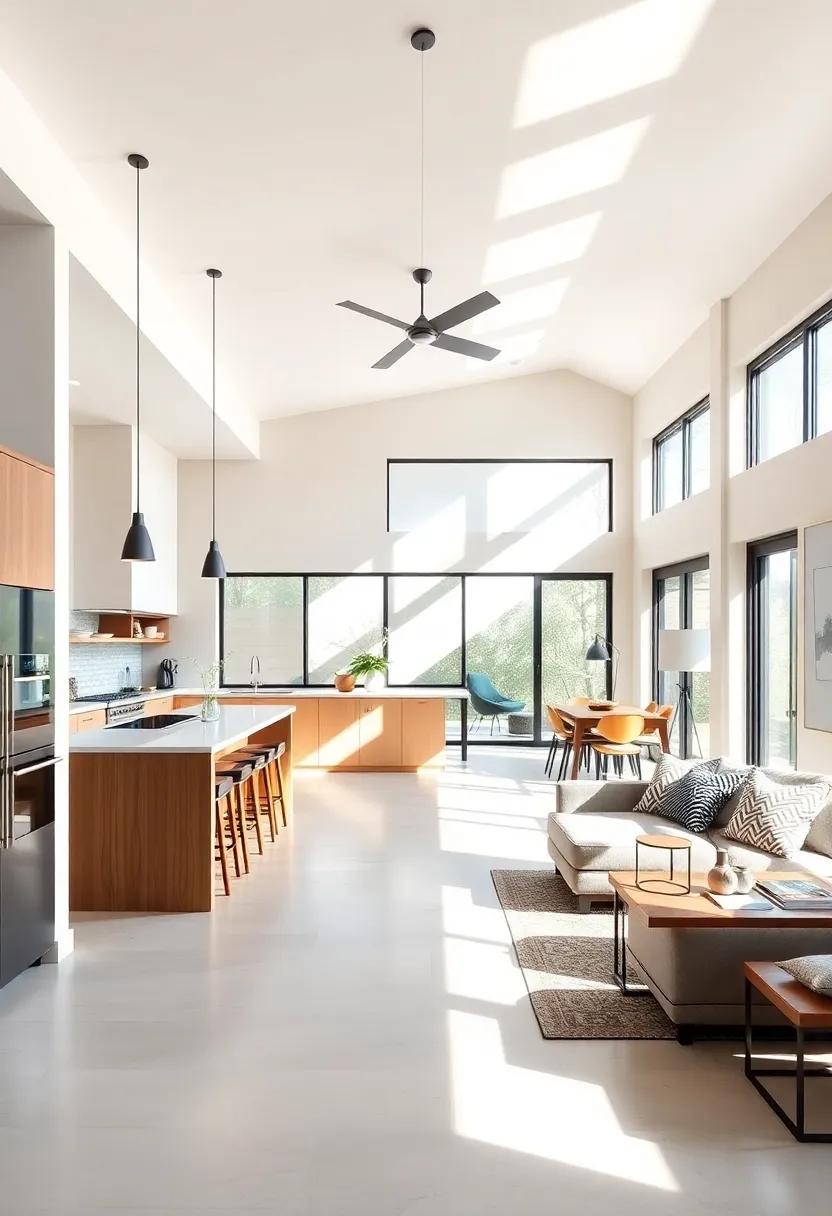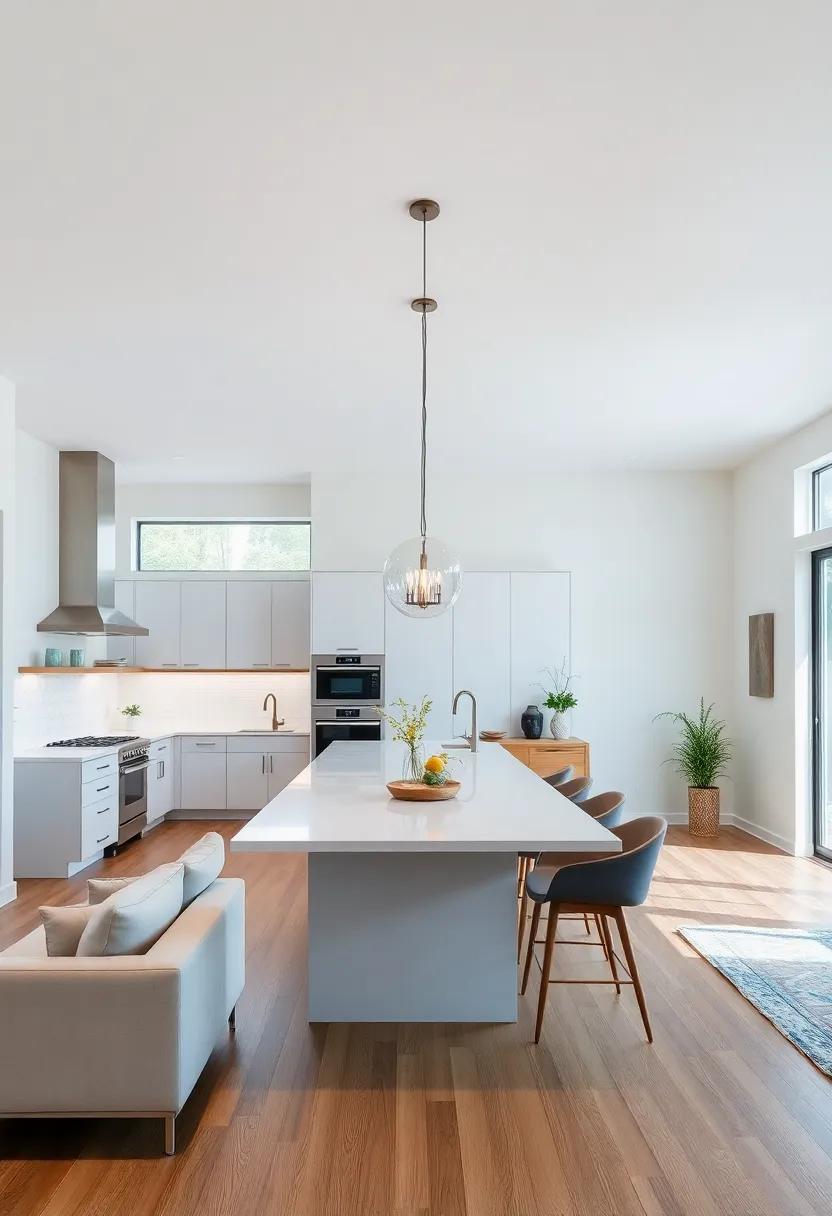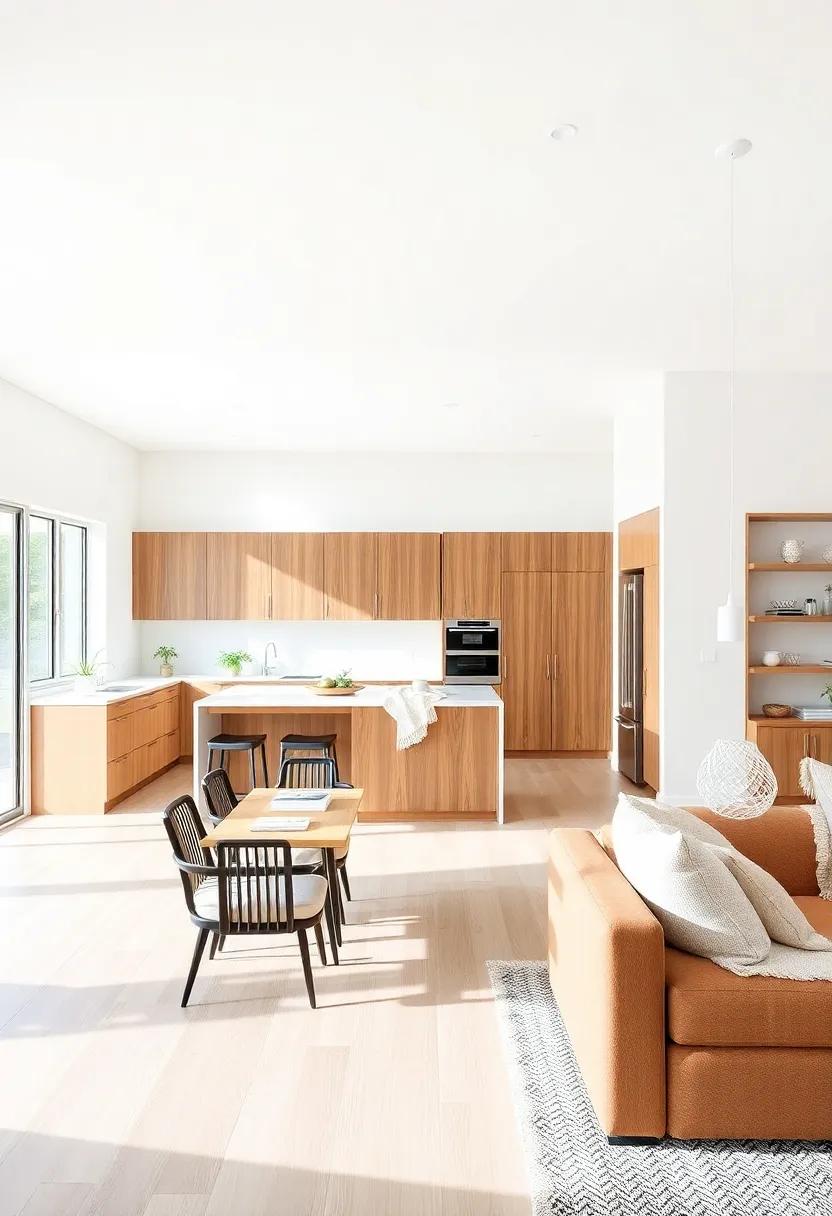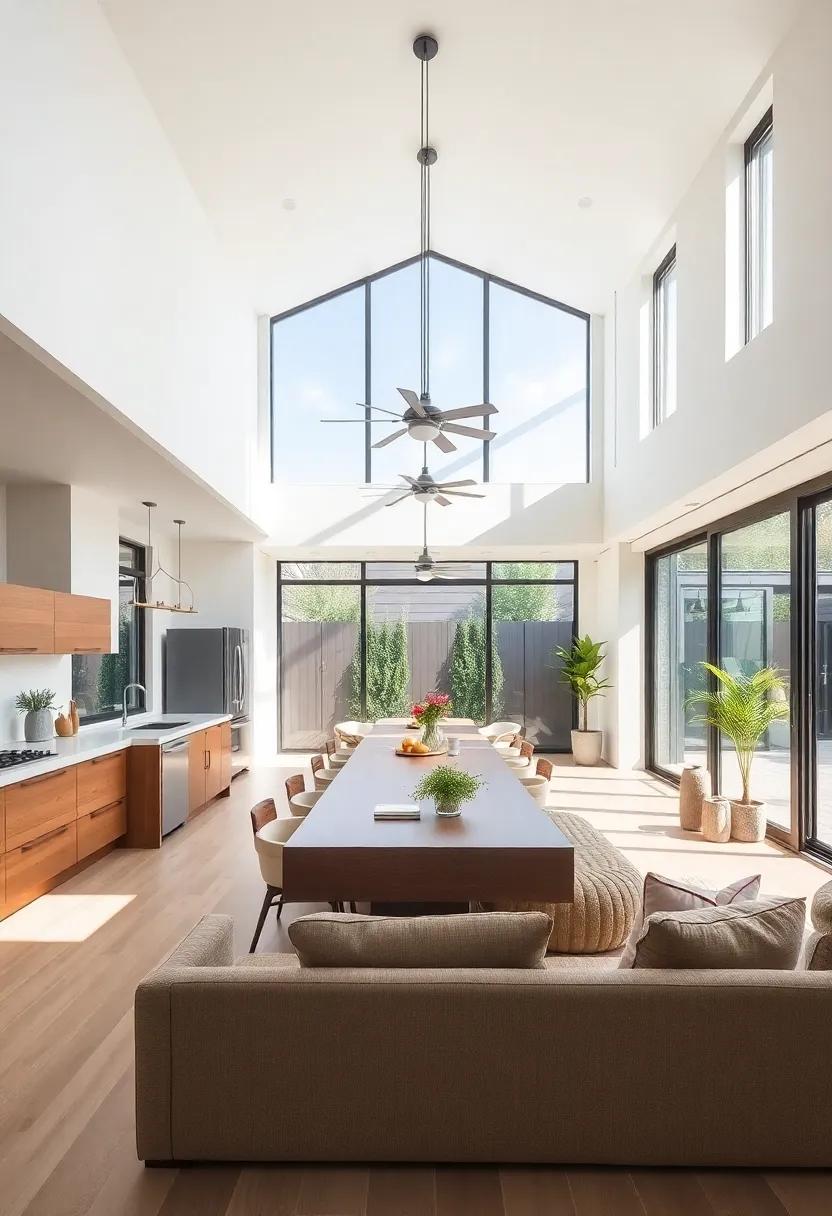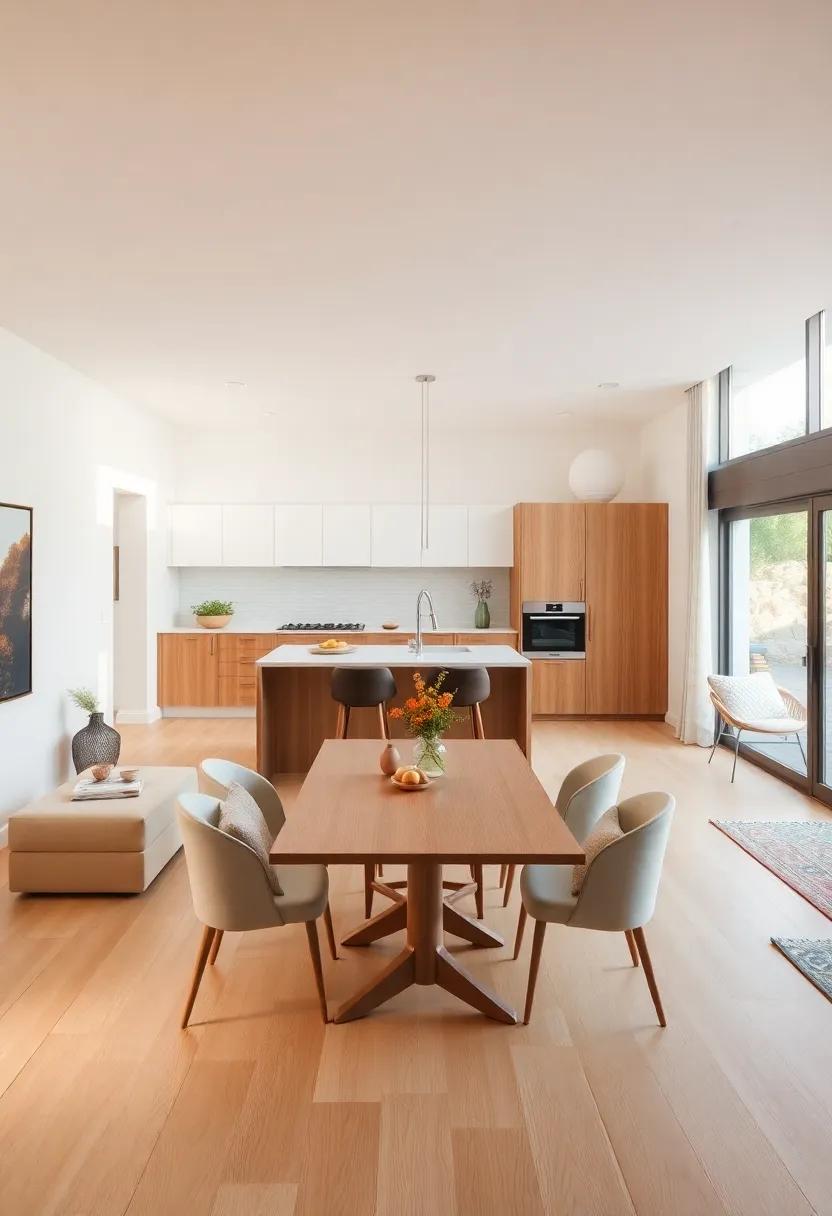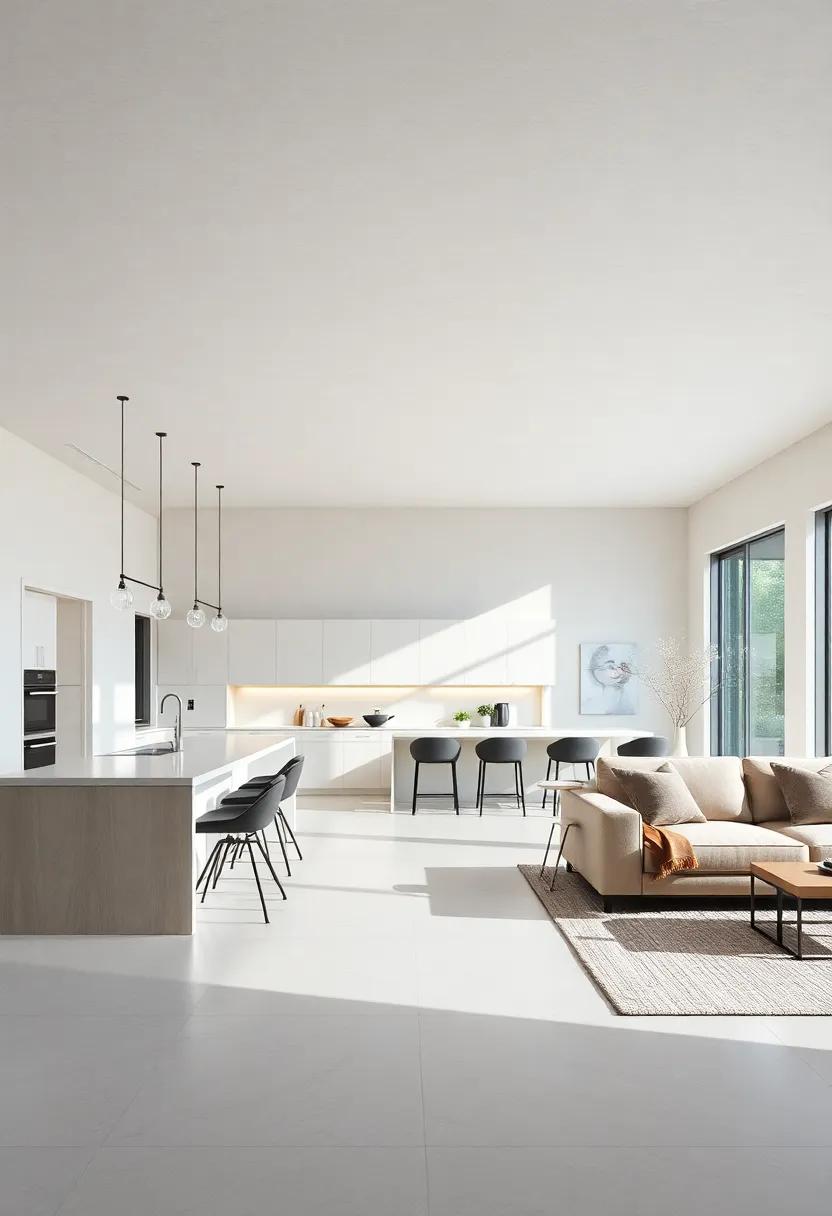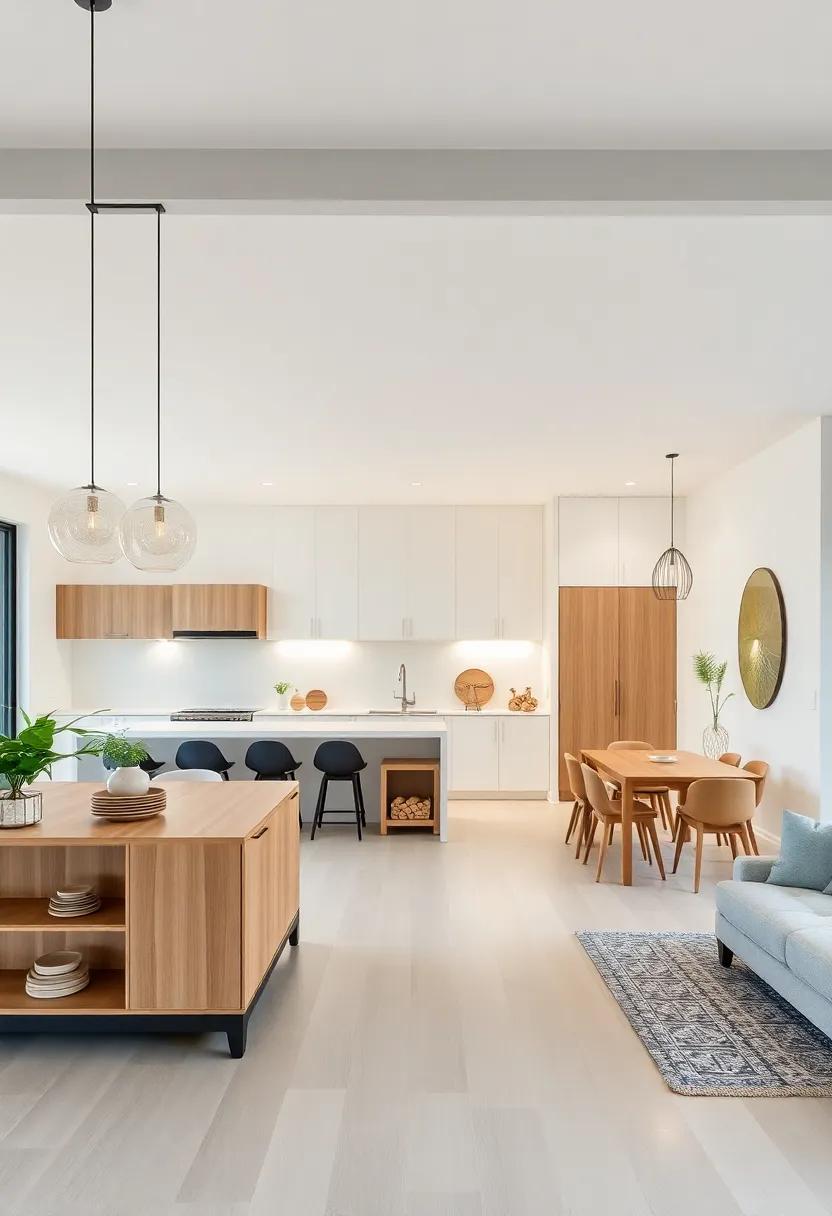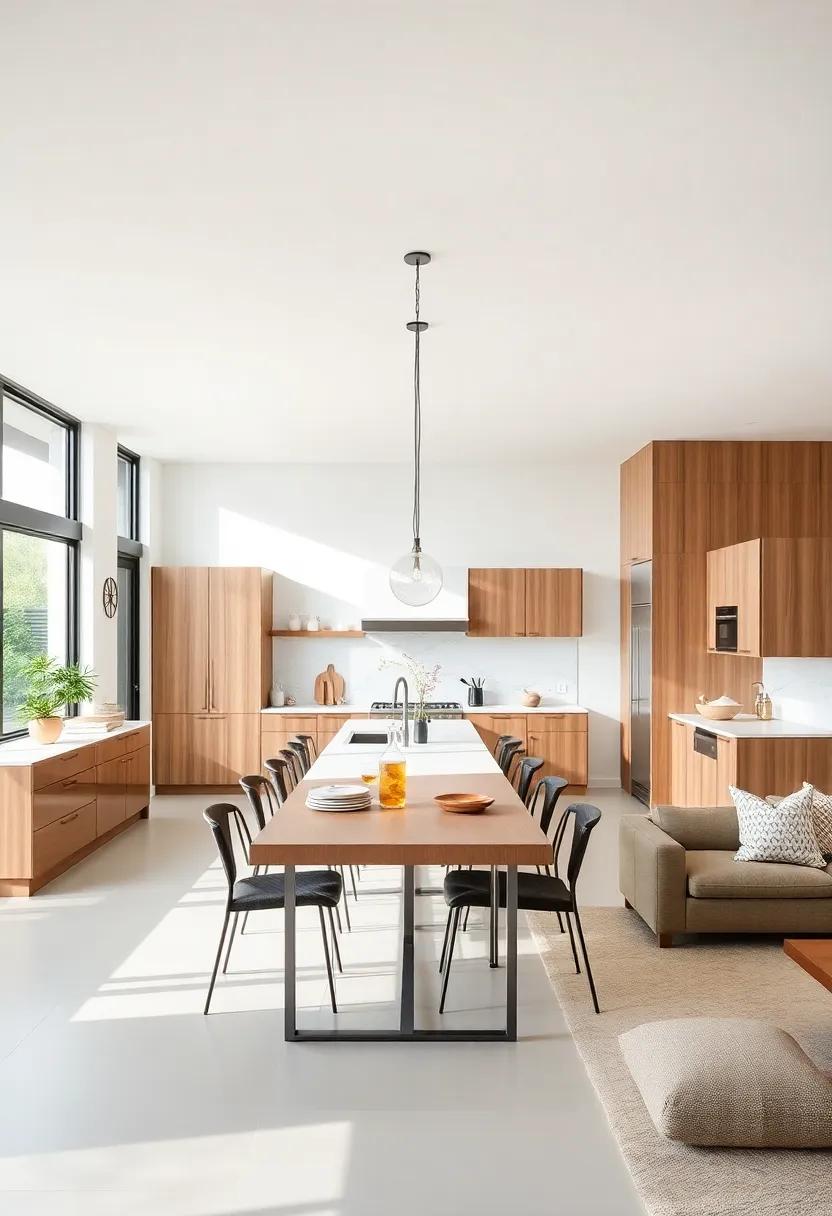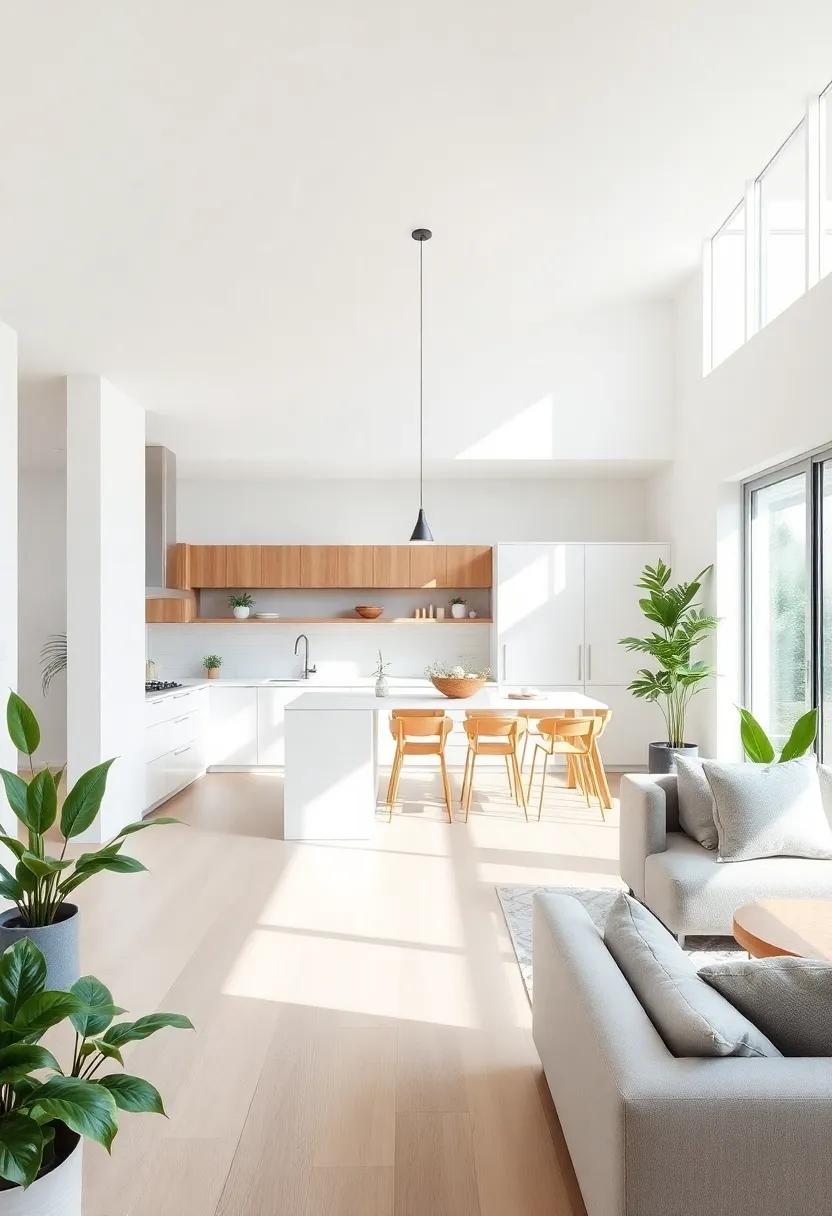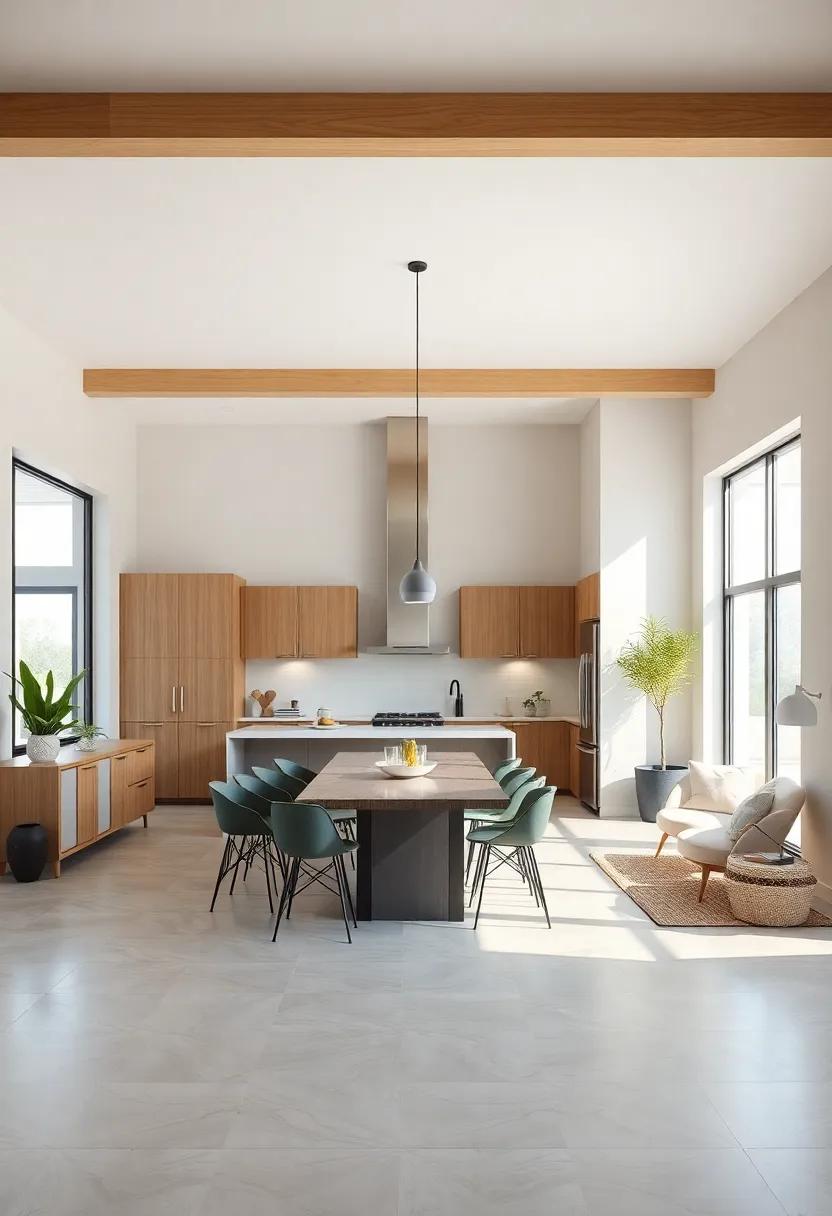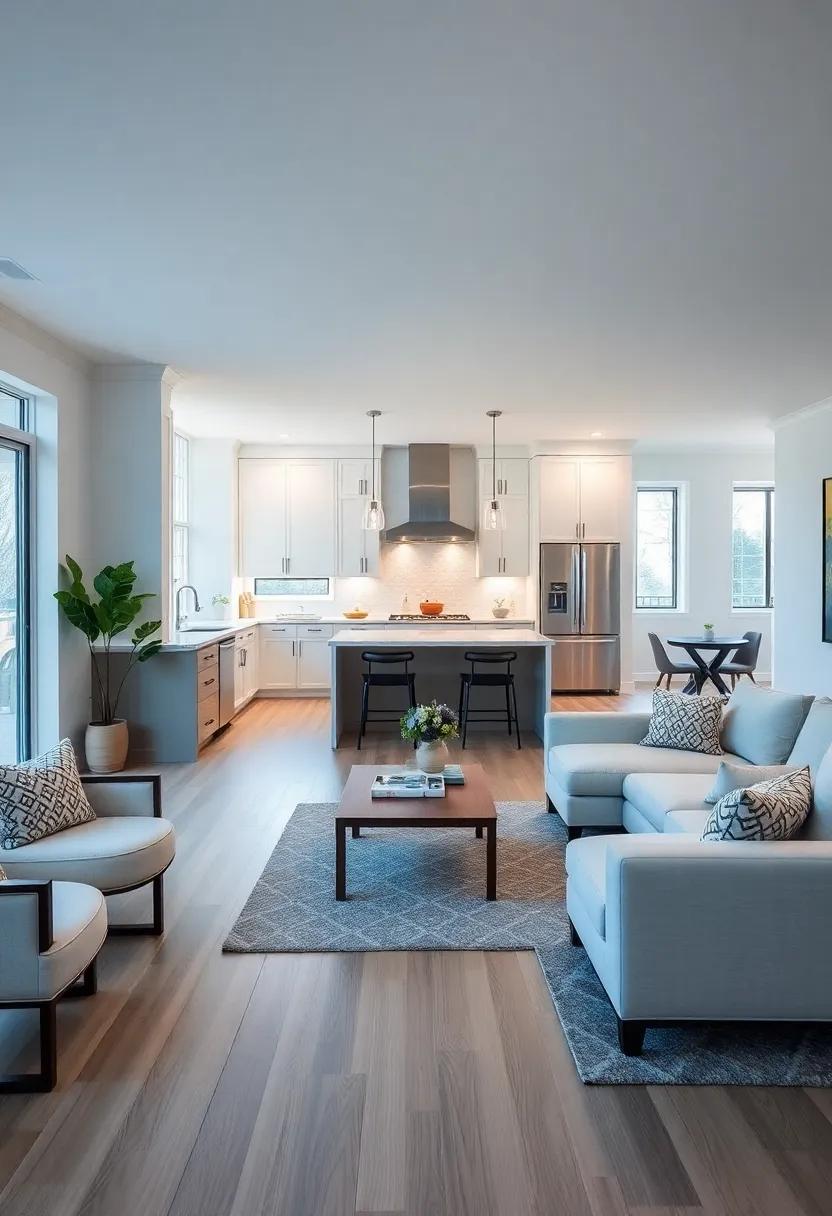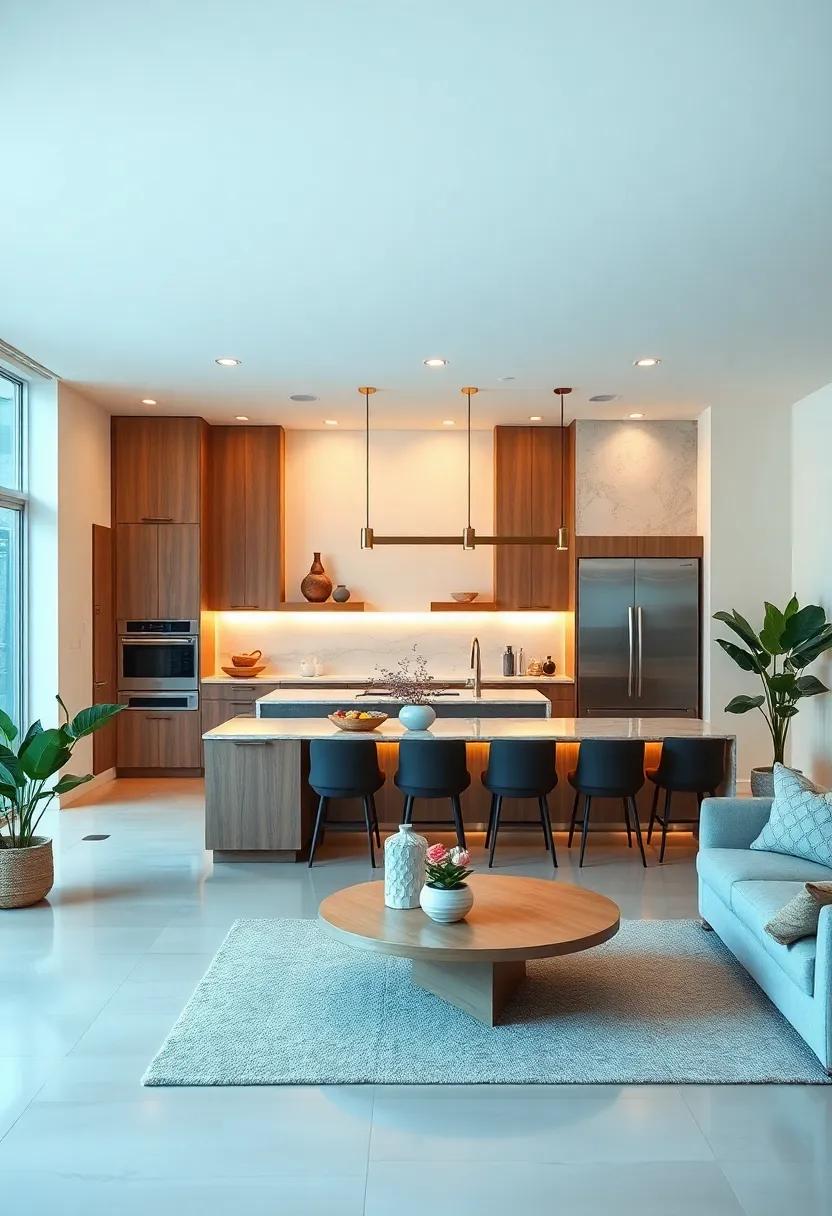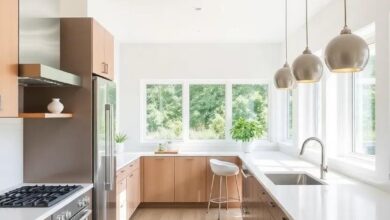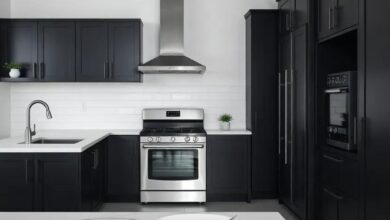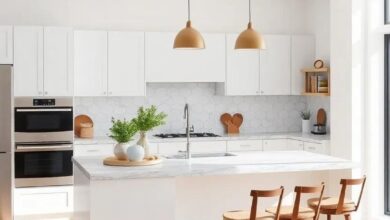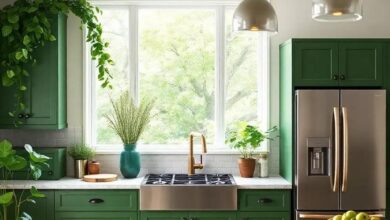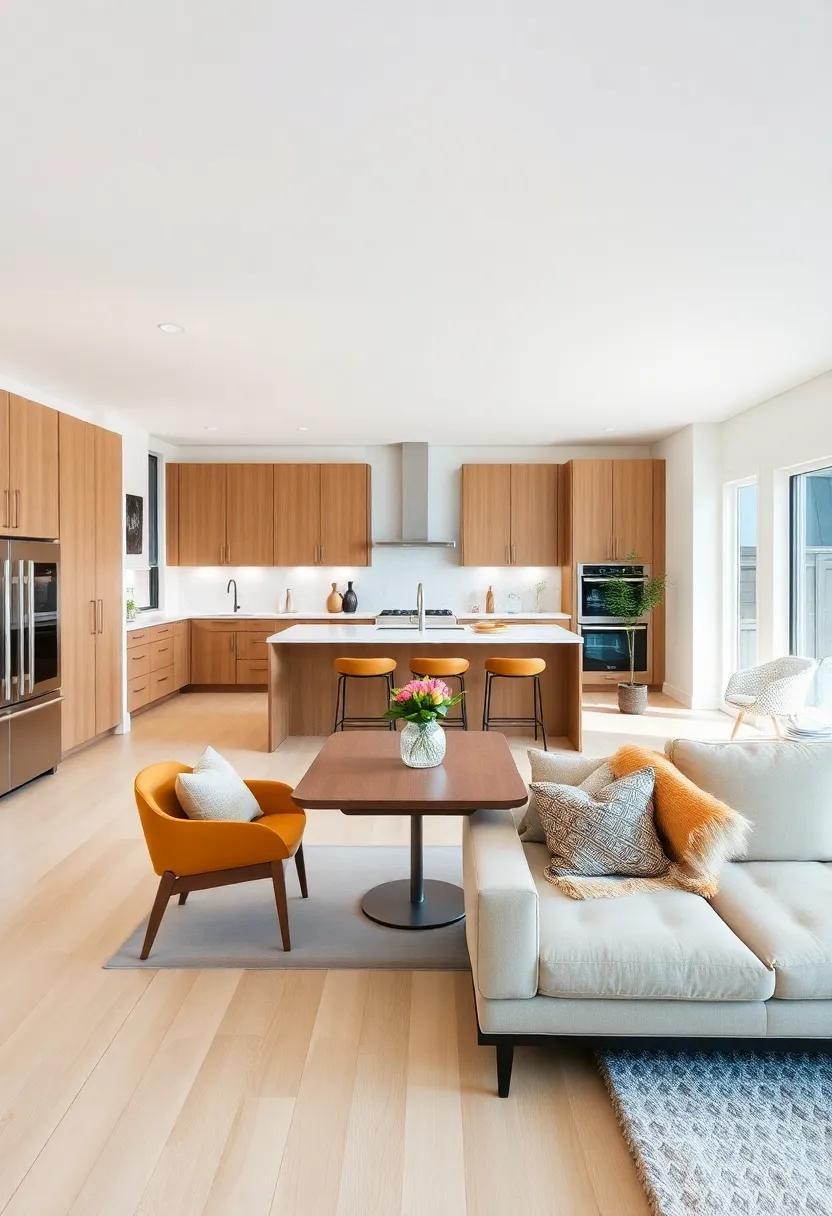
Embracing Togetherness: The Allure of Open Concept Kitchen and Family Room Design
in a world that frequently enough seems to pull us in different directions, the heart of many homes is evolving to bring us closer together. The open concept kitchen and family room design has emerged as a sanctuary of connection and collaboration, where laughter mingles with the aroma of home-cooked meals, and conversations flow as freely as the light that floods through expansive spaces. This architectural trend, marked by its seamless blend of shared spaces, invites families and friends to gather, creating moments that are cherished and memories that last. As we delve into the allure of this design, we will explore how embracing togetherness can transform not just our living environments, but also our experiences and relationships within them. Join us as we uncover the beauty and functionality of creating spaces that invite connection and celebration in our daily lives.
Embracing the Heart of the Home through Open Concept Design Choices
Open concept design transcends mere aesthetics, transforming ordinary spaces into harmonious environments that promote connection and interaction. By creating a seamless flow between the kitchen and family room, families can gather, communicate, and engage more naturally. This layout allows for multifunctional spaces, where activities like cooking, entertaining, and casual lounging can occur in proximity. Key features to consider include:
- Strategic Furniture Placement: Arrange furniture to encourage conversation and easy movement.
- Integrated Lighting: Use a mix of ambient, task, and accent lighting to create a welcoming atmosphere.
- Visual Cohesion: incorporate a unified color palette and materials that flow seamlessly from one area to the next.
Moreover, embracing an open concept can enhance the overall functionality of yoru space, allowing for easy supervision of children while preparing meals or hosting friends. Consider the integration of smart technology to streamline tasks; for instance, voice-activated devices can facilitate hands-free cooking or music control. Below is a simple table illustrating essential elements to blend style and functionality:
| element | Purpose |
|---|---|
| Island Kitchen | Encourages gathering and provides additional prep space. |
| Open Shelving | displays kitchenware while keeping essentials accessible. |
| Bar Seating | Creates a casual eating space and social hub. |
The Seamless flow Between Kitchen and Living Spaces for Social Connection
The modern design ideology is all about fostering connections, and the unified floor plan of an open kitchen and living area epitomizes this spirit. Here, cooking transforms from a solitary task into a communal activity, allowing friends and family to engage in conversation while preparing meals. Such arrangements invite a sense of warmth and intimacy, encouraging spontaneous gatherings, weather it’s a casual breakfast or a festive dinner party.Key elements that enhance this flowing dynamic include:
- Central Islands: Functioning as both a workspace and a social hub, islands facilitate interaction.
- Open Sightlines: Unobstructed views create a sense of togetherness, making it easy for everyone to stay connected.
- Integrated Design: Matching materials and color palettes encourage a visual cohesiveness that melds the two spaces seamlessly.
Furthermore, the integration of multifunctional furniture and thoughtful layout plays a crucial role in maintaining the energy of the space.Flexible seating arrangements can cater to both intimate family dinners and larger gatherings, while movable decor can adapt to various occasions. Here’s how you can enhance the social and aesthetic appeal of your combined areas:
| Feature | Benefit |
|---|---|
| Open Shelving | Promotes accessibility and displays cherished items, adding personality to the space. |
| Lighting Fixtures | Creates ambiance and encourages people to gather, enhancing the overall mood. |
| Colorful Accents | Provides visual interest and can define areas within the open layout. |
Balancing Functionality and Aesthetics in Family-Centric Areas
In crafting a harmonious space that encourages family interactions, the balance between practicality and visual appeal is essential. It’s critically important to consider features that enhance convenience while maintaining a welcoming atmosphere. A few strategic choices can considerably impact this balance:
- Flexible Seating: Incorporate a mix of seating options such as stools at the kitchen island and a cozy couch in the family room to accommodate various activities.
- Durable Materials: Opt for surfaces that are stylish yet resilient, like quartz countertops or water-resistant fabrics, ensuring that the space can withstand the wear and tear of family life.
- open Connectivity: Design pathways that promote easy movement between the kitchen and family area, allowing seamless transitions during meal prep and gatherings.
Functionality shouldn’t overshadow aesthetics; rather, it can complement it beautifully. Consider using a cohesive color palette that reflects both warmth and style, tying the areas together visually. Additionally, incorporating elements such as:
| Design element | Function | Aesthetic Value |
|---|---|---|
| Open Shelving | Easy access to kitchenware | Adds character and openness |
| Statement Lighting | Light up key areas | Creates ambiance |
| Natural Textiles | Comfortable atmosphere | Enhances the visual warmth |
When these elements are thoughtfully combined, the result is a family-centric environment that radiates style while remaining undeniably functional.
Exploring the Role of Natural Light in open Concept Environments
In open concept environments,natural light plays a transformative role,blurring the lines between indoor and outdoor spaces. The strategic placement of windows and glass doors allows sunlight to flood the room,creating a warm and inviting atmosphere that encourages family gatherings and social interactions. This design approach not only enhances the aesthetic appeal but also supports the psychological well-being of inhabitants.Research shows that exposure to natural light can improve mood, boost productivity, and even regulate sleep patterns, making it a crucial element in contemporary living spaces.
the benefits of incorporating natural light in these expansive layouts are multi-faceted.Consider the following advantages:
- Enhanced Visual Appeal: Shining, well-lit spaces create an illusion of more room, making the area feel even more expansive.
- Energy Efficiency: Strategically designed windows can reduce reliance on artificial lighting, contributing to energy savings.
- Connection with Nature: Large windows provide visual access to outdoor landscapes,fostering a sense of tranquility.
- Health Benefits: Increased natural light can assist in vitamin D absorption and contribute to overall physical health.
Creating Intimate Spaces Within an Expansive Open Layout
Transforming an expansive open layout into a cozy haven requires thoughtful designs that establish zones while maintaining a cohesive flow. A few key elements can definitely help create intimate areas within the larger space:
- Rug Placement: Layering rugs can delineate different areas, such as a cozy reading nook or a dining space, allowing each zone to feel distinct yet connected.
- Furniture Arrangement: Arranging seating in a circular or U-shape fosters conversation and warmth, making the space feel less like a wide-open expanse and more like a welcoming retreat.
- Lighting variations: Utilizing multiple light sources, including pendant lights and sconces, can add warmth and intimacy, creating an inviting ambiance for gatherings.
Incorporating visual barriers, such as decorative screens or bookshelves, can also help to define different functional areas without sacrificing openness. Strategically placed plant life not only enhances aesthetics but also provides a natural divider that invites tranquility into the bustling space. Consider the following design table as a guide to balance openness with intimacy:
| Design Element | Function | tip |
|---|---|---|
| Rugs | Space definition | Choose varied textures |
| Seating Arrangements | Encourages interaction | Opt for curved layouts |
| Lighting | Creates mood | Mix brightness levels |
| Plants | Adds warmth | Use varying heights |
Color Schemes That Foster Unity and Energy in Open Areas
Creating an environment that radiates unity and energy requires a thoughtful selection of color schemes. Warm hues such as soft oranges, gentle yellows, and invigorating reds can stimulate conversation and connection, instilling a sense of warmth and welcome. These shades evoke feelings of excitement and fun, making them ideal for spaces where family and friends gather. Complement these vibrant colors with neutral tones like cream or light gray to provide balance and ensure the atmosphere feels harmonious without overwhelming the senses.
In addition to warm tones,incorporating cool colors like calming blues and refreshing greens can enhance the feeling of tranquility in your shared living space. These colors not only inspire relaxation but also promote creativity and mind engagement, making them ideal for open-concept designs where cooking, dining, and leisure activities converge. To illustrate this concept,consider the following table showcasing effective color combinations that foster togetherness:
| color Pairing | vibe |
|---|---|
| Warm Orange & Cream | Inviting and Energetic |
| Soft Blue & Light Grey | Calm and Refreshing |
| Gentle Yellow & Sage Green | Cheerful and Harmonious |
| Brick Red & Beige | Cozy and Welcoming |
Furniture Selection Techniques for Harmonious interaction Zones
Selecting the right furniture in an open concept kitchen and family room is crucial for fostering a warm and inviting atmosphere. When curating these spaces, consider the following elements to promote harmonious interaction:
- Scale and Proportion: Choose furniture that complements the scale of the space.Oversized sofas can overwhelm, while too-small pieces can feel lost.
- Coherent Style: Whether you opt for modern minimalist or rustic charm, maintain a consistent style throughout furniture selections to enhance flow.
- Multi-Functional Pieces: Consider furniture that serves multiple purposes, such as ottomans with storage or dining tables that can extend for gatherings.
- Connection Points: Use color schemes and materials that create intermittent visual touchpoints between zones, such as a color-matched throw on the sofa that echoes the kitchen curtains.
To facilitate ease of movement and interaction, arranging furniture strategically is key. Employ the focal point approach to create visual interest while encouraging social engagement:
| Zone | Focal Point | Recommended Arrangement |
|---|---|---|
| Kitchen | Island or Counter | Stools arranged perpendicularly for casual seating and conversation. |
| Family Room | Fireplace or TV | Seating grouped in a circular formation to promote interaction. |
Incorporating Personalized Touches to Enhance Family dynamics
To foster a sense of belonging and intimacy within your home, personalized touches play a pivotal role. Consider integrating elements that reflect your family’s heritage and shared experiences. This could range from custom art pieces created by family members to a gallery wall showcasing cherished moments. You might also want to incorporate functional designs that highlight daily routines,such as a chalkboard for shared meals or a family calendar that keeps everyone on the same page. These subtle yet meaningful additions make the space not just visually appealing, but profoundly personal.
Additionally, the color palette and materials in the open concept area can communicate warmth and unity. Think about using warm wood accents or soft textiles that evoke comfort yet have a contemporary edge. Incorporating a community table not only invites conversation during meal readiness but also conveys the essence of togetherness. Here’s a simple table comparing various items that can bring your family closer:
| Personalized Touch | Potential Impact |
|---|---|
| Custom Art | Enhances emotional connection |
| Family Calendar | Keeps everyone organized |
| Community Table | encourages togetherness |
Each element, while small on its own, contributes to a larger tapestry of shared memories and experiences. By weaving these personalized artifacts into your open concept design, family dynamics naturally flourish, making every gathering feel special and important.
The Importance of Flexible Design for Dynamic Family Lifestyles
In today’s fast-paced world, family dynamics are constantly changing, necessitating a design that can adapt to varied needs and lifestyles. The ability to create spaces that are not only functional but also inviting plays a crucial role in fostering togetherness. A flexible environment allows families to effortlessly transition from cooking to entertaining, from relaxation to collaborative activities, creating a seamless flow that encourages interaction.
Key elements of a flexible design include:
- Multifunctional Furniture: Think ottomans with storage or fold-out tables that can expand for gatherings.
- Open Layouts: minimal barriers enhance sightlines and sound, fostering connection.
- Adjustable Spaces: Rooms that can be reconfigured easily to suit different occasions and sizes of gatherings.
- Versatile Decor: Choosing styles and colors that can easily transition from one mood to another allows for personalization.
| Design Feature | Family Benefit |
|---|---|
| Open Concept Layout | Encourages family interaction during meals and activities. |
| Movable Islands | Provides additional surface space when needed, without permanent commitments. |
| Cozy Nooks | creates intimate spaces for quiet moments or family bonding. |
By prioritizing these design aspects, homes can evolve alongside their residents, accommodating everything from family dinners to quiet reading time. this adaptability not only heightens the functionality of a space but also enriches the emotional connections that families build in their homes.
Integrating Technology for Modern Comfort in Open spaces
As we transform open spaces into inviting family hubs, technology integration plays a pivotal role in enhancing comfort and functionality. Imagine adjusting your lighting, thermostat, and entertainment systems, all from a single device, allowing family members to personalize their experiences. This seamless blend of technology invites us to create an atmosphere where everyone can share moments together, whether cooking a family meal or enjoying movie night. Key elements to consider include:
- Smart Lighting: Adapt the ambience with dimmers and color changes using an app.
- Multimedia Integration: Install speakers that connect with various devices for synchronized sound throughout the space.
- Climate Control: Use smart thermostats to maintain an ideal temperature for any occasion.
Furthermore, the incorporation of technology can streamline daily tasks and improve the overall aesthetic of open spaces. With smart kitchen appliances, meal preparation becomes a breeze, allowing families to spend less time cooking and more time connecting. Utilizing innovative solutions, such as a kitchen island with built-in charging stations, can also reduce clutter and keep everyone powered up. A swift comparison of traditional versus modern integrated spaces highlights significant benefits:
| Feature | Traditional Space | Modern Integrated Space |
|---|---|---|
| Design Versatility | Limited customization | highly adaptable |
| Convenience | Manual devices | Smart home systems |
| Family Interaction | Segmented experiences | Shared activities |
Maximizing Storage While Preserving Open Concept Charm
In an open concept kitchen and family room, finding ways to maximize storage without sacrificing the inviting atmosphere can be a delightful challenge.Consider integrating multi-functional furniture that serves dual purposes to enhance usability while keeping clutter at bay. For instance, a stylish ottoman can provide extra seating and hidden storage for blankets or games. Additionally, utilizing vertical space with floating shelves or tall cabinets can draw the eyes upward, making the area feel more spacious while cleverly accommodating essentials.
Another effective strategy is to embrace custom cabinetry that fits seamlessly into the design. Built-in solutions can respond to your specific needs without overwhelming the aesthetic. By opting for open shelving in certain areas, you can showcase beautiful dishware or decor while keeping a minimalistic approach to everyday items. Include a well-placed kitchen island not only as a prep space but as a central hub for both storage and social interaction. Here’s a simple visual representation of recommended storage solutions:
| Storage solution | Benefits |
|---|---|
| Multi-Functional Furniture | Dual purposes,protects floors from clutter |
| Floating Shelves | Maximizes vertical space,provides display options |
| Custom Cabinetry | Tailored storage,maintains design harmony |
| Open shelving | showcases personality,reduces bulkiness |
| Kitchen Island | Prep space,social gathering spot,extra storage |
bridging Indoor and Outdoor Living in Open concept Designs
In the pursuit of harmony between indoor and outdoor spaces, open concept designs act as a seamless canvas where life unfolds naturally. By integrating large windows, sliding doors, and airy layouts, homeowners can invite natural light and fresh air into their living areas, creating an environment that feels expansive and inviting. The flow between the kitchen, family room, and adjoining outdoor terraces or gardens promotes a sense of togetherness, where families can engage in cooking, dining, or relaxing while being in touch with nature. Imagine hosting friends while the aroma of freshly baked bread wafts through wide-open spaces that link your kitchen to a sun-drenched patio.
The aesthetic choices in such designs significantly enhance the connection between these realms. Utilizing natural materials like wood and stone in both indoor furnishings and outdoor landscaping helps blend the two environments, providing a cohesive look. Furthermore,layering textures with thoughtful decor can enhance the warmth of the interior while complementing the beauty of the exterior. Consider the following elements to enrich this union:
- Transitional Flooring: Use similar flooring materials, such as wood or stone, that extend from indoors to outdoors.
- Consistent Color Palette: Choose colors that reflect the surrounding nature, creating a visual dialog.
- Outdoor Living Areas: Build patios or decks that mimic indoor comfort with cozy furniture and lighting.
Designing Zones for Cooking,Dining,and Relaxation to support Togetherness
in an open-concept design, the kitchen, dining, and relaxation zones merge seamlessly, encouraging interaction and fostering a sense of community.By strategically positioning these areas, each zone complements the other, creating spaces that are not only functional but also inviting. Consider using island counters to define the cooking space,while together providing a casual gathering point for friends and family. Dining tables can be situated near the kitchen for easy access, making meal transitions fluid and stress-free. Adding comfortable seating options around these areas enhances the environment,allowing for casual conversations or playful meal prep together.
To truly embrace togetherness, it’s important to incorporate elements that promote engagement. Integrating warm lighting and earthy colors can set a welcoming tone, while multi-functional furniture can serve various purposes. For instance, a table that doubles as a workspace lends itself to both family projects and meal times. additionally, designing an outdoor connection point, such as large glass doors leading to a patio, can extend gatherings into nature, further enhancing the communal experience. By weaving together functionality and comfort, each zone becomes a vital ingredient in the recipe for togetherness.
The Role of Textures in Defining Distinct Areas within Open Spaces
Textures play a vital role in transforming large, open spaces into inviting environments that promote interaction and connection. By employing a careful mix of materials, you can visually delineate areas within kitchen and family room designs while maintaining that coveted open-concept feel. Consider incorporating soft textiles, such as plush cushions and cozy throws, alongside natural elements like wood and stone.This combination not only adds depth to your space but also creates a sensory experience that invites family members and guests to gather and engage. Whether it’s a smooth dining table surface contrasting with a rugged stone backsplash, the juxtaposition of textures fosters a balanced atmosphere amidst the openness.
In addition to textiles and materials, the use of color can further enhance the definition of distinct areas. For instance, you might choose a bold accent wall or vibrant decor for the family room to differentiate it from the kitchen area’s more subdued palette. Here’s a simple table illustrating how various textures and colors can demarcate spaces effectively:
| Area | Texture | Color Palette |
|---|---|---|
| Kitchen | Glass and Stainless Steel | Neutral Grays and Whites |
| Family room | Soft Fabrics and Woven Materials | Warm Earth Tones |
| Dining Area | Wood and Stone | Deep Greens and Rich Blues |
This careful attention to textures and colors not only improves the aesthetics of your open space but also establishes a comfortable and functional environment that encourages togetherness. When thoughtfully integrated, these elements harmonize to create distinct yet cohesive areas that enhance the experience of your home.
Inspiring Family Bonding through Collaborative Cooking Environments
Creating a collaborative cooking environment not only enhances the culinary experience but also strengthens family ties. An open concept kitchen easily transforms into a dynamic hub where everyone can contribute their own flair to meals. The modern layout encourages young chefs to anxiously await their turn at the counter,while parents delight in sharing techniques and recipes. Gathering around a large island or a stylish butcher block fosters interaction,making the process of preparing meals feel less like a chore and more like a joyful adventure.
As families engage in cooking together, they not only craft flavorful dishes but also build lasting memories. Consider incorporating elements that stimulate participation:
- Interactive Cooking Stations: Different spots designated for various tasks—mixing,chopping,or seasoning—allow everyone to join in.
- themed Cooking Nights: Choose a cuisine each week, prompting everyone to select ingredients or try their hand at creating unique dishes.
- Recipe Cards: Encourage family members to contribute their favorite recipes, creating a personal cookbook over time.
With each culinary collaboration, the kitchen transforms from a simple cooking space into a cherished intersection of love, laughter, and learning.
Creating a Culinary Experience that Encourages Interaction and Sharing
In an open concept kitchen and family room, design isn’t just about aesthetics; it’s about fostering an environment that invites collaboration and connection. Imagine a space where the hustle and bustle of culinary preparation merges seamlessly with laughter and conversation, creating a vibrant atmosphere. Interactive cooking stations encourage guests to roll up their sleeves and get involved in the process, transforming what could be a solitary activity into a shared experience. Incorporating elements like an island with seating can provide a casual gathering spot,making it easy for people to mingle while delicious meals come together. Consider these elements to enhance interaction:
- Sleek islands with built-in cooktops for live cooking demonstrations.
- Multifunctional spaces that allow for socializing, dining, and preparing food.
- Open shelving that showcases beautiful ingredients and encourages experimentation.
Moreover, sharing isn’t limited to the act of cooking alone; it extends to the presentation and enjoyment of food. Create designated areas for food displays, such as a charming charcuterie board or an inviting dessert table, to inspire conversation and community spirit. This not only emphasizes the importance of sharing a meal but also promotes a sense of togetherness.to further enhance the experience, consider incorporating a simple layout for a potluck style dinner, bringing favorite family recipes into the mix.
| Element | Benefits |
|---|---|
| Interactive Cooking Stations | Encourage participation and teamwork. |
| Central Island with Seating | Fosters a casual gathering space. |
| Food Presentation Areas | Invites sharing and conversation. |
Incorporating Nature with Indoor plants and Sustainable Choices
Infusing life into an open concept kitchen and family room can be effortlessly achieved by integrating indoor plants, which not only enhance the aesthetic appeal but also promote well-being. Low-maintenance plants are notably favored in high-traffic areas, offering a touch of greenery without demanding too much attention. Consider incorporating the following options:
- Snake Plant: Perfect for busy households, thrives in low light.
- Pothos: Versatile and trailing; ideal for shelves and hanging baskets.
- Spider Plant: Known for its air-purifying qualities and charming foliage.
In addition to selecting the right plants, opting for sustainable choices can further enhance your space. Utilizing eco-pleasant materials and furnishings designed from recycled or sustainably sourced items can create a harmonious environment. Below is a simple guide to sustainable elements that can complement your kitchen and family room:
| Material Type | Sustainability Advantage |
|---|---|
| Reclaimed Wood | Reduces deforestation and adds character. |
| Bamboo | Fast-growing and requires less water. |
| Recycled Metal | Minimizes waste and offers durability. |
Assessing Traffic Flow to Enhance Communication and Togetherness
To cultivate an atmosphere of connectivity, it is essential to evaluate how individuals navigate through open spaces. Traffic flow within an open concept kitchen and family room directly influences interactions and the overall ambiance. Key considerations include:
- Pathways: Establish clear pathways that allow easy movement between areas.
- Focal Points: Position furniture and fixtures to create focal areas, encouraging gatherings.
- Accessibility: Ensure that all areas are accessible to everyone, promoting inclusivity.
By sculpting an inviting layout, homeowners can enhance not only the functionality of their space but also their relationship with family and friends. A well-designed environment can foster spontaneous conversations and shared moments,strengthening bonds. Consider the following factors when assessing your space:
| Aspect | Impact on Togetherness |
|---|---|
| Open Sightlines | Encourages visual connection among family members |
| Multi-Functional Islands | Serves as a gathering point for cooking and conversation |
| seating Arrangements | Facilitates easy interaction and communal dining experiences |
Innovative Lighting Solutions to Illuminate Open Family Gathering Spaces
Transforming open family gathering spaces into vibrant hubs of connection requires more than just furniture placement; it demands innovative lighting solutions that enhance the atmosphere.Consider layered lighting as a focal point,combining ambient,task,and accent lighting to create depth and warmth. Key elements of this approach include:
- Floor Lamps: Add stylish floor lamps to corners for cozy reading nooks.
- Pendant Lights: Use statement pendant lights above kitchen islands to provide focused illumination.
- Smart LEDs: Incorporate smart LED systems that allow for color and intensity adjustments with a simple voice command.
Lighting not only offers practicality but also serves as a design element that can unify your space.For instance, utilizing dimmers can help create a welcoming atmosphere during family dinners, while brighter settings can energize the area when hosting friends for game nights. Here’s a quick comparison of different lighting types to consider:
| Lighting Type | Benefits |
|---|---|
| Task Lighting | Provides focused illumination for activities. |
| Ambient Lighting | Creates a soft glow that invites relaxation. |
| Accent Lighting | Highlights artwork or architectural features. |
Capturing the Essence of Togetherness with Strategic Layout Planning
Designing a space that fosters connection involves a meticulous blend of functionality and aesthetics. An open concept kitchen and family room not only enhances the visual flow but also encourages interactions among family members and guests. The layout allows for seamless transitions between cooking, dining, and relaxation, making it an ideal environment for shared moments. key elements such as strategic seating arrangements,ample surface areas,and carefully placed lighting can significantly elevate the sense of togetherness while maintaining a harmonious design. Consider incorporating:
- Island seating for casual conversations
- Defined zones using rugs or different materials
- Integrated technology for entertainment and connectivity
Moreover, harmonizing colors and textures across both spaces can further encapsulate the feeling of unity. Using a cohesive color palette and complementary materials fosters not only visual appeal but also emotional comfort, encouraging everyone to gather and engage. A thoughtfully planned lighting scheme can enhance this ambiance: pendant lights over the kitchen island can create a focal point while softer, ambient lighting in the family room sets a more relaxed atmosphere. to underline the beauty of this setup, consider the following layout elements:
| Element | Purpose |
|---|---|
| Open Sightlines | Facilitate conversations and monitor children |
| Multi-functional Furniture | Provide flexibility for gatherings and everyday use |
| Natural Materials | Create warmth and an inviting atmosphere |
Insights and Conclusions
the allure of open concept kitchen and family room design lies in its ability to weave together the threads of everyday life, fostering intimacy and interaction among family members and friends. As we move towards more flexible,communal living spaces,it becomes clear that these designs do more than just serve a functional purpose; they embody a lifestyle that cherishes connection and collaboration. By embracing togetherness,we create environments where cooking,dining,and relaxation seamlessly blend,transforming mere rooms into vibrant hubs of life and laughter. Whether you’re renovating an existing space or dreaming up your next project, consider how the open concept can enhance not just your home, but the relationships that flourish within it. So, let’s celebrate the movement towards unity, where boundaries fade, and the heartbeat of the home comes alive in the light and warmth of togetherness.
As an Amazon Associate I earn from qualifying purchases.
